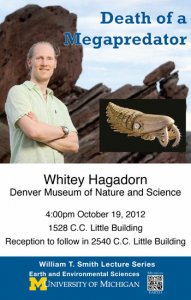Presented By: Earth and Environmental Sciences
Death of a Megapredator: Whitey Hagadorn, Denver Museum of Nature and Science
Smith Lecture

Anomalocaridids were the first large predators, and are thought to have been ferocious consumers of trilobites and other prey that inhabited early Paleozoic seas. Like Tyrannosaurus rex, sabre-toothed cats, and similar apex predators, they first became known from a famous deposit - the Cambrian Burgess Shale. Aside from their iconic status, anomalocaridids also play an important role in our understanding of Earth history and evolution because they are keystone organisms. They are keystones because our interpretations of their biology and ecology, based on the morphology of fossils, anchor our understanding of how entire marine ecosystems functioned. Yet new finite element modeling, taphonomic, and mineralogic analyses of these extinct creatures seems to contradict the longstanding interpretation of the biology and ecology of these animals, suggesting rather that they may have been small, that their mouths were soft, that they could not close their mouth, and that they could not have possibly eaten trilobites. Similarly, analyses of malformed or "bitten" trilobites interpreted to be prey suggests that they could not have been deformed by the mouth or appendages of any known anomalocaridid. Analysis of putative anomalocaridid coprolites from the same deposits suggests that coprolites were produced by other animals or inorganic processes. Based on this new work, it is unclear if these iconic predators were really just small worm-suckers or whether they were early plankton combers. Regardless, this new data could substantially change the way we interpret the complexity of ancient ecosystems, the evolution of large arthropods and their kin, and biogeochemical feedback loops in organic-rich muddy settings.